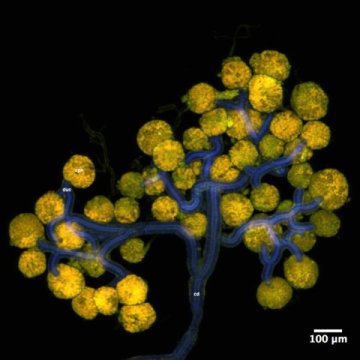[ad_1]
Carabid beetles produce caustic chemicals they spray to defend themselves against predators, and the compound that protects their bodies from these toxic substances shows promise for use in bioengineering or biomedical applications, according to Penn State researchers.
The family Carabidae represents an extremely diverse line of insects, with almost 40,000 species. One of the traits that allows them to thrive is a unique gland system. It manufactures, stores and propels toxic chemicals — such as formic acid, phenolics and concentrated hydrogen peroxide — to ward off insect, amphibian and even small mammalian predators that want to eat the beetles.
Located in the abdomen, the pygidial glands consist of defensive-chemical-producing lobes, which are connected to a muscularized reservoir chamber via a long collecting duct. In most carabid beetles, this reservoir opens with a duct at the tip of the abdomen. The tissues that comprise the gland system and contain the defensive chemicals have long been a mystery to entomologists.
“We had no idea what these tissues were made of,” said Tanya Renner, assistant professor of entomology, whose research group in the College of Agricultural Sciences recently discovered that the elastomeric protein resilin allowed carabid beetles to be the chemists of the insect world. “They produce more than 250 different compounds to protect themselves.”
No previous studies suggested how the insects are able to avoid damage to gland components caused by potential stress generated from reservoir-pump contractions or the corrosive effects of the defensive chemicals they contain. However, using an investigative process pioneered in previous Penn State entomological research — autofluorescence-based laser scanning microscopy — researchers found the answer.
Using this method, during which tissues emit different wavelengths of light depending upon their contents, the researchers closely examined Pennsylvania ground beetles. They found the tissues in the glandular system transporting the defensive chemicals to be rich in soft, rubbery resilin, a compound found in many insects and other arthropods. Resilin provides elasticity to mechanically active tissues such as flea leg joints or locust wing-hinges. But resilin was not previously known to be in beetle glandular systems.
The beetles can spray their pygidial gland contents a distance many times their body length, noted lead researcher Adam Rork, doctoral student in entomology. When Pennsylvania ground beetles are not defending themselves they are friends of agriculture, consuming up to their body weight daily, eating pests such as aphids, moth and beetle larvae, as well as slugs and snails.
Rork collected ground beetles for the study — the findings of which were published today (Feb. 25) in Arthropod Structure & Development — from agricultural fields a few miles from Penn State’s University Park campus. He dissected the insects and prepared the abdominal tissues for scanning at the Penn State Microscopy and Cytometry Facility.
He suggested that carabid beetle pygidial glands — rich in resilin — are a key innovation and evolutionary adaptation that has allowed one of the animal kingdom’s largest families to survive through the ages.
“While much work has been done to describe the morphology of these glands in many subfamilies, there has been little work done on their tissue composition,” he said. “Our findings are crucial to understanding not only how these structures evolved, but also how they withstand the stress of containing and ejecting cytotoxic chemicals.”
Beyond advancing the understanding of insect tissues’ composition, Renner believes resilin is a compound that is likely to be used in future bioengineering and biomedical applications due to its unusual properties. She explained that there is currently interest among scientists in the compounds that insects and spiders produce because these structures have evolved and proven they are strong enough to hold up in the real world.
“They persist and are often better than synthetics,” she said. “Since it is impermeable, highly resistant to chemicals and flexible, resilin appears to be a strong candidate for a barrier material in applications where we need to keep two different chemicals away from each other but within the same environment.”
Another potential use is in tissue engineering, Rork added. Resilin has many similarities with elastin, a protein found in human bodies, and could be used to design new tissue for people with degenerative diseases or injuries.
This research was made possible by the Penn State Microscopy and Cytometry Facility, Renner said, which offers easy access and training for students to sophisticated instruments.
“It’s not just the infrastructure but the staff there available to students that is so unusual — that’s what makes Penn State entomology so special.”
Story Source:
Materials provided by Penn State. Note: Content may be edited for style and length.
[ad_2]















